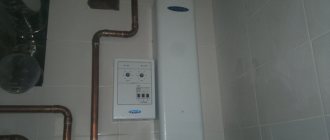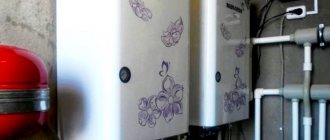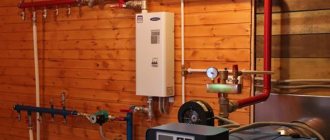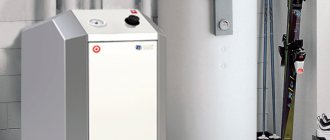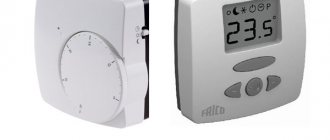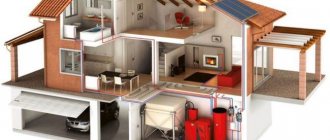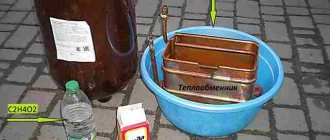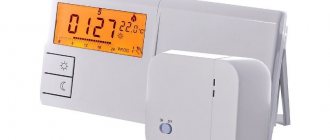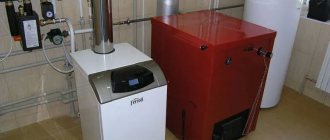This topic will cover:
- electrical diagrams of boilers;
- possible causes of boiler breakdowns and ways to eliminate them,
options for connecting electric boilers will also be considered for:
- two-wire single-phase network;
- four-wire three-phase network with a neutral wire.
For the two connection methods, you need to know that when connecting any electrical equipment, and we are talking about electric boilers that are equated to this category, the connection is made with grounding.
In this topic, the casings of electric boilers are subject to grounding.
Why does this need to be taken into account? - Then, in the event of a breakdown of the conductor phase insulation on the metal parts of the body and a person accidentally touches the body of the electric boiler, the current potential in the human body decreases.
Replacing the heating element
Replacing the heating element and other elements, as well as diagnostics to determine the cause of the malfunction, is carried out in a passive way when the electrical equipment is disconnected from the external alternating voltage source.
This issue cannot be resolved on your own if you are not an electrician and such work is carried out accordingly if you have knowledge of the regulatory documents of the electrical safety approval group.
So what is the need for these details? — You may ask, if in this or that case there is a malfunction, you can call the electrician directly.
Well, let's put it this way - knowledge of electrical and electrical engineering will not be superfluous for you.
Connecting an electric boiler
Let's consider connecting the EVAN S1-30 electric boiler to a four-wire, three-phase network with a neutral wire.
The fifth PE conductor in the diagram in Fig. 1 is grounding and is connected to the body of the EVAN S1-30 electric boiler. Reading the connection diagram:
The electric boiler is equipped with so-called buses; a network cable with a plug is connected to buses N, A, B, C. From the buses, three phases A, B, C have branching. One branch of phases A, B, C is connected to the first contacts of the heating elements of two blocks.
The second branch from the same four buses is connected through a starter to the second contacts of the heating elements of two blocks.
Here it should be taken into account that for each individual block with heating elements, each individual heating element is connected to phase wires as follows:
Phase A and neutral wire N from the busbars are connected to the control panel. In its combination, the control panel is connected to a voltage of 220 V, the conductors from the control panel are connected:
- with pump;
- with air temperature sensor;
- with thermostat sensor;
- with self-resetting thermal switch.
The control panel consists of electronic elements that are not indicated in the diagram.
For electronic elements, diagnostics are outlined in this blog.
After carrying out repairs to replace one or another electrical part:
- block with heating elements;
- self-resetting thermal switch
and other parts included in the electrical circuit, it is necessary, before connecting the electric boiler to an external source of alternating voltage, to check the electrical circuit of the boiler for resistance. Diagnostics of the resistance in the electrical circuit of this circuit is carried out either with an ohmmeter or a multimeter with the appropriate function.
If, as a result of measuring resistance, the device indicates a zero value, in this example you should reconsider the connections you have made. A zero resistance number indicates a short circuit in the electrical circuit.
Consider the following electrical circuit for two types of boilers EPO-7.5 and EPO-9.45. The electrical circuit shown in Fig. 2 is identical and the difference here is only in the power of electric boilers. Let's follow the connection diagram:
These types of electric boilers are connected to a two-wire, single-phase network. The PE grounding wire is connected to the heating element block and to the body of the electric boiler. The phase wire from the phase bus in this circuit has a branching, one wire with phase potential goes to the control panel and is connected from the control panel to the first contacts of the heating elements,
Installation stages
Installation of the harness consists of several stages:
- First, marking and installation are done. To avoid a short circuit in the event of a boiler leak, it is placed away from the water supply. To install this device, dowels or anchor bolts are used. The boiler is leveled horizontally and vertically using a level. When choosing a floor-standing model, place a special stand under it.
- Then the electric boiler is connected to the heating system using adapters and couplings. Before this, the water is first shut off using taps of any type.
- After completing the connection of the boiler to the system, it is necessary to complete the electrical part of the structure, which consists of an RCD and a circuit breaker. To connect the boiler it is necessary to make grounding. All electrical cables are placed in a special casing and laid in channels intended for wiring. The cable cross-section depends on the power of the equipment.
- After the electrical part, grounding is done and the heating system is tested.
Technical features of boilers
The product range of boilers is represented by the following series:
The “Standard” series is represented by the “Economy” and “Standard” models. All boilers of the standard category are characterized by the ability to smoothly adjust the coolant temperature and are equipped with an input for connecting a circulation pump. The design of these boilers is extremely simple and consists of a metal cylinder, in the lower part of which there is a heating element, and in the upper part there is a temperature regulator sensor.
The line of this series is rich in models of varying power - from 2.5 kW to 30 kW. For heating large areas, the additional installation of a circulation pump and an expansion tank is required. Typically used as electric boilers for home and small offices.
Devices in this category differ in their equipment - for example, depending on the power, the models contain a certain number of heating elements and connectors for connecting room temperature sensors.
Among private property owners, devices of this series are most in demand.
Electric boilers "Evan" have different technical characteristics in this series, depending on the presence or absence of a three-stage switch, a built-in circulation pump, and an electronic control unit. Accordingly, more expensive models have all three mechanisms, while economical models only have a three-stage power switch. The boiler power range is from 3.5 kW to 30 kW. They are used as electric boilers for homes, offices, and warehouses.
Boilers of this series have very high power characteristics - thus, the model range is represented by units with heating output from 36 kW to 480 kW. The boilers have (not in all models) four-stage power regulation, protection against short circuits, inappropriate pressure, overheating and overload.
Evan boilers: pros and cons
Among the disadvantages of electric heating boilers for the Evan home are the dependence on electricity and its high consumption. However, the listed disadvantages are more or less characteristic of most electric heaters. Regarding Evan boilers specifically, many owners complain about the noisy operation of the devices, unreliable heating elements, frequent relay breakdowns and failure of the boiler automation.
Therefore, when choosing a boiler, it is better to consult with a company specialist, because the causes of breakdowns are often caused by operating conditions, instability of the supplied electricity, incorrectly executed connection diagram of the electric heating boiler and other reasons not related to manufacturing defects.
Speaking about the advantages of these Russian boilers, they usually highlight their low cost, ease of installation, a huge selection of models and ease of operation. In addition, the devices have all the advantages of electric boilers as such.
In this series, they note the absence of the need to prepare fuel and install a chimney (as is required in the case of gas and solid fuel boilers), high efficiency (99%) and a level of safety (subject to high-quality electrics).
How to heat a living space using an Evan electric boiler?
Using electric heating equipment is a convenient, safe and environmentally friendly way to heat homes and commercial properties.
When purchasing an Evan electric boiler, you can choose a model that meets the specified parameters from a wide range of products. JSC Evan, which began its history in 1996 as a small manufacturing enterprise, is today the manufacturer of every third electric heating boiler in Russia. High demand is explained by the cost-effectiveness, reliability and ease of maintenance of the equipment.
Features of connecting electric boilers
Even for a non-specialist, the connection diagram for an electric heating boiler is clear, so installing the device will not be difficult. To understand how to install, you should know what devices you will be working with and what their purpose is.
So, during installation you will have to mount the boiler itself, various regulators, and an expansion tank on the wall (or on the floor). Depending on the purpose, one or more main circuits are connected to the boiler. Also, depending on the model, installation of a circulation pump and boiler unit may be required.
Before proceeding with installation, you should familiarize yourself with a document such as the connection diagram for an electric heating boiler, which the manufacturer encloses with the package of documents for the unit. In accordance with this document, the device is connected to other devices in the heating network.
It should be borne in mind that if the boiler power does not exceed 3.5 kW, it can be plugged into an outlet. Otherwise, electrical installation is carried out directly from the junction box.
Moreover, if the power of the device exceeds 7 kW, the use of a three-phase network of 380 V will be required. The boiler must be protected by an RCD and a circuit breaker.
We should not forget about grounding the wiring.
More on this topic on our website:
- Gas boilers Proterm Bear 30 KLOM - technical characteristics and features Heating boilers “Bear” from the Slovak manufacturer Protherm are completely independent of electricity; the source of thermal energy is gas fuel. Proterm Bear 30 KLOM.
Electric boiler EVAN EPO ECONOMY - review and reviews from owners These electric boilers of the ECONOMY series, produced by , which has now ceased to be independent, and were bought by the large NIBE holding, are completely.
Solid fuel boiler KChM 5 - technical characteristics and reviews KChM 5 boilers are produced by the Kirov plant, founded in the 18th century. Over the years of operation, the boiler has proven itself to be very reliable.
Heating gas boiler Danko - technical characteristics and reviews is Ukrainian. In addition to gas boilers, the company produces a number of other heating devices - solid fuel and.
Delivery terms
The delivery driver can provide loader services only by prior arrangement for an additional fee.
Upon delivery to the Buyer, the seller is responsible for the appearance of the goods until the moment of acceptance and transfer to the Buyer. Claims regarding the appearance and configuration of the delivered goods, in accordance with Art. 458 and 459 of the Civil Code of the Russian Federation, can only be presented before the goods are transferred by the Seller to the Buyer. From the moment of acceptance and delivery of the goods, the seller’s obligation to transfer the goods is considered fulfilled. The fact of acceptance of the goods by the Buyer is confirmed by a signature in the “Purchase and Sale Agreement” in the column “Acceptance and Transfer Certificate”. If the appearance or configuration of the goods does not correspond to the proper quality, the buyer has the right not to accept the goods and not to sign the documents.
